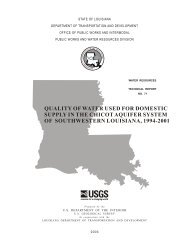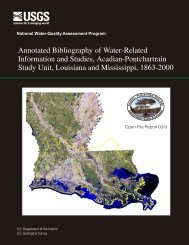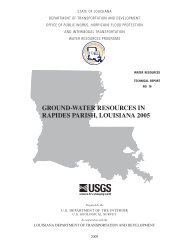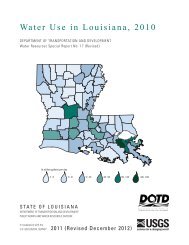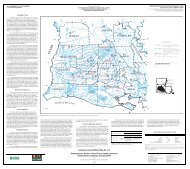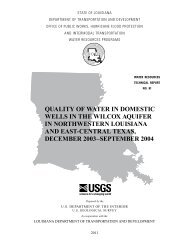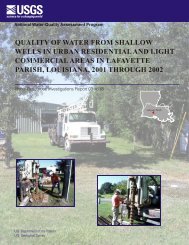environmental setting, water quality, and ecological indicators of
environmental setting, water quality, and ecological indicators of
environmental setting, water quality, and ecological indicators of
You also want an ePaper? Increase the reach of your titles
YUMPU automatically turns print PDFs into web optimized ePapers that Google loves.
aquatic life is exposed to both ground <strong>water</strong> <strong>and</strong> surface<br />
<strong>water</strong>. Also, tidal effects <strong>and</strong> bidirectional flows preclude<br />
the use <strong>of</strong> stage-discharge relations to calculate<br />
streamflow at all but the most upstream sites. The<br />
bidirectional-discharge hydrographs from the Mermentau<br />
<strong>and</strong> Lacassine sites define specific hydrologic conditions<br />
only at those two locations. They are useful in<br />
describing the overall hydrologic conditions in the basin,<br />
but cannot provide information such as loads that can be<br />
used for management decisions. For these reasons the<br />
integrated assessment for this study <strong>of</strong> surface-<strong>water</strong><br />
<strong>quality</strong>, ground-<strong>water</strong> <strong>quality</strong>, bed-sediment <strong>quality</strong>, <strong>and</strong><br />
<strong>ecological</strong> <strong>indicators</strong> is restricted to approximately<br />
2,000 mi 2 <strong>of</strong> the Mermentau River Basin north <strong>of</strong> the<br />
Lake Arthur <strong>and</strong> Lacassine sites.<br />
Aquatic Invertebrate Communities<br />
The most important factors influencing the occurrence<br />
<strong>and</strong> distribution <strong>of</strong> aquatic invertebrates are stream<br />
velocity, <strong>water</strong> temperature, dissolved substances, <strong>and</strong><br />
substrate (Hynes, 2001). Because <strong>of</strong> low <strong>water</strong> velocities,<br />
elevated <strong>water</strong> temperatures, <strong>and</strong> soil types <strong>of</strong> the<br />
Mermentau River Basin, an aquatic environment that is<br />
not conducive to a diverse aquatic invertebrate community<br />
is expected. Snags provide a firm substrate <strong>and</strong><br />
opportunities for colonization <strong>of</strong>ten lacking in the clays<br />
<strong>and</strong> mucks <strong>of</strong> the streambed <strong>and</strong> banks. Snags also allow<br />
aquatic invertebrates to move closer to the <strong>water</strong> surface<br />
during periods <strong>of</strong> low dissolved-oxygen concentrations<br />
<strong>and</strong> high turbidities. These populations typically include<br />
the larvae <strong>of</strong> chironomid midges, snails, amphipod crustaceans,<br />
<strong>and</strong> worms. DeWalt (1997), in a study designed<br />
to locate <strong>and</strong> characterize wadeable reference streams in<br />
this basin, noted that low dissolved-oxygen concentrations<br />
significantly distinguish this area from other Louisiana<br />
lowl<strong>and</strong>s.<br />
The Mermentau River Basin, especially in the midto-lower<br />
reaches, typically supports dense growth <strong>of</strong><br />
exotic macrophyte (aquatic plant) species. Among these<br />
are <strong>water</strong> hyacinth (Eichhornia crassipes), alligator<br />
weed (Alternanthera philoxeroides), <strong>and</strong> <strong>water</strong> spangle<br />
(Salvinia minima). During mild winters these macrophytes<br />
may not experience a complete dieback <strong>and</strong> may<br />
cover the <strong>water</strong> surface, reducing light penetration <strong>and</strong><br />
lowering dissolved-oxygen concentrations. These<br />
plants, however, provide extensive habitat for aquatic<br />
invertebrates. Amphipod crustaceans in particular can be<br />
found in abundance among the root systems <strong>of</strong> <strong>water</strong><br />
hyacinth.<br />
Naturally occurring habitat conditions in the basin<br />
favor an aquatic invertebrate community tolerant <strong>of</strong> turbidity,<br />
organic enrichment, <strong>and</strong> low dissolved-oxygen<br />
12<br />
conditions. The net effect <strong>of</strong> these natural <strong>environmental</strong><br />
stressors is to produce a biological community that is, at<br />
first examination, indicative <strong>of</strong> streams that have been<br />
adversely affected by human activities. However, what<br />
may appear to be a degraded or depauperate biological<br />
assemblage may in fact be a healthy community where<br />
multiple <strong>environmental</strong> stressors limit diversity <strong>and</strong> sensitive<br />
taxa.<br />
DATA COLLECTION AND METHODS OF<br />
STUDY<br />
Ground-<strong>water</strong> sample collection was consistent<br />
with national goals for the ground-<strong>water</strong> component <strong>of</strong><br />
the NAWQA program (Leahy <strong>and</strong> others, 1990). Samples<br />
were collected from wells drilled specifically for the<br />
NAWQA program <strong>and</strong> from existing domestic wells that<br />
met specific criteria. Surface-<strong>water</strong> samples were collected<br />
from 24 long- <strong>and</strong> short-term sites with varied<br />
agricultural intensity in the Mermentau River Basin.<br />
These sites are referred to in this report by the site names<br />
listed in table 1. Long-term sites were sampled to characterize<br />
temporal <strong>and</strong> spatial <strong>water</strong>-<strong>quality</strong> conditions,<br />
<strong>and</strong> short-term sites were sampled to characterize <strong>water</strong><br />
<strong>quality</strong> during the spring months.<br />
Water samples from wells <strong>and</strong> surface-<strong>water</strong> sites<br />
were collected for the analysis <strong>of</strong> nutrients, major inorganic<br />
ions, trace elements, <strong>and</strong> pesticides; samples from<br />
surface-<strong>water</strong> sites also were analyzed for suspended<br />
sediment. Water samples were collected from 29 wells<br />
(fig. 1). The wells were sampled once during the period<br />
January 2000-January 2001, <strong>and</strong> the well depths ranged<br />
from 19 to 230 ft. Surface-<strong>water</strong> samples were collected<br />
at 25 sites (24 sites in the Mermentau River Basin <strong>and</strong><br />
one additional site in the Calcasieu River Basin) during<br />
the period <strong>of</strong> sample collection for the study described in<br />
this report. Bed-sediment samples were collected at 17<br />
sites (table 1) during low-flow conditions August-September<br />
2000. Aquatic invertebrate samples <strong>and</strong> stream<br />
habitat data were collected at 18 sites in the Mermentau<br />
River Basin <strong>and</strong> at one additional site in the Calcasieu<br />
River Basin during March-April 2001.<br />
Procedures used to collect <strong>and</strong> process <strong>water</strong> samples<br />
followed st<strong>and</strong>ard USGS guidelines <strong>and</strong> are<br />
described by U.S. Geological Survey (1997 to present),<br />
Shelton (1994), Gilliom <strong>and</strong> others (1995), Mueller <strong>and</strong><br />
others (1997), <strong>and</strong> Koterba <strong>and</strong> others (1995). Water<br />
samples were analyzed at the USGS National Water<br />
Quality Laboratory (NWQL) in Denver, Colo., using<br />
methods described by Fishman <strong>and</strong> Friedman (1989),<br />
S<strong>and</strong>strom <strong>and</strong> others (1992), S<strong>and</strong>strom (1995), Zaugg



